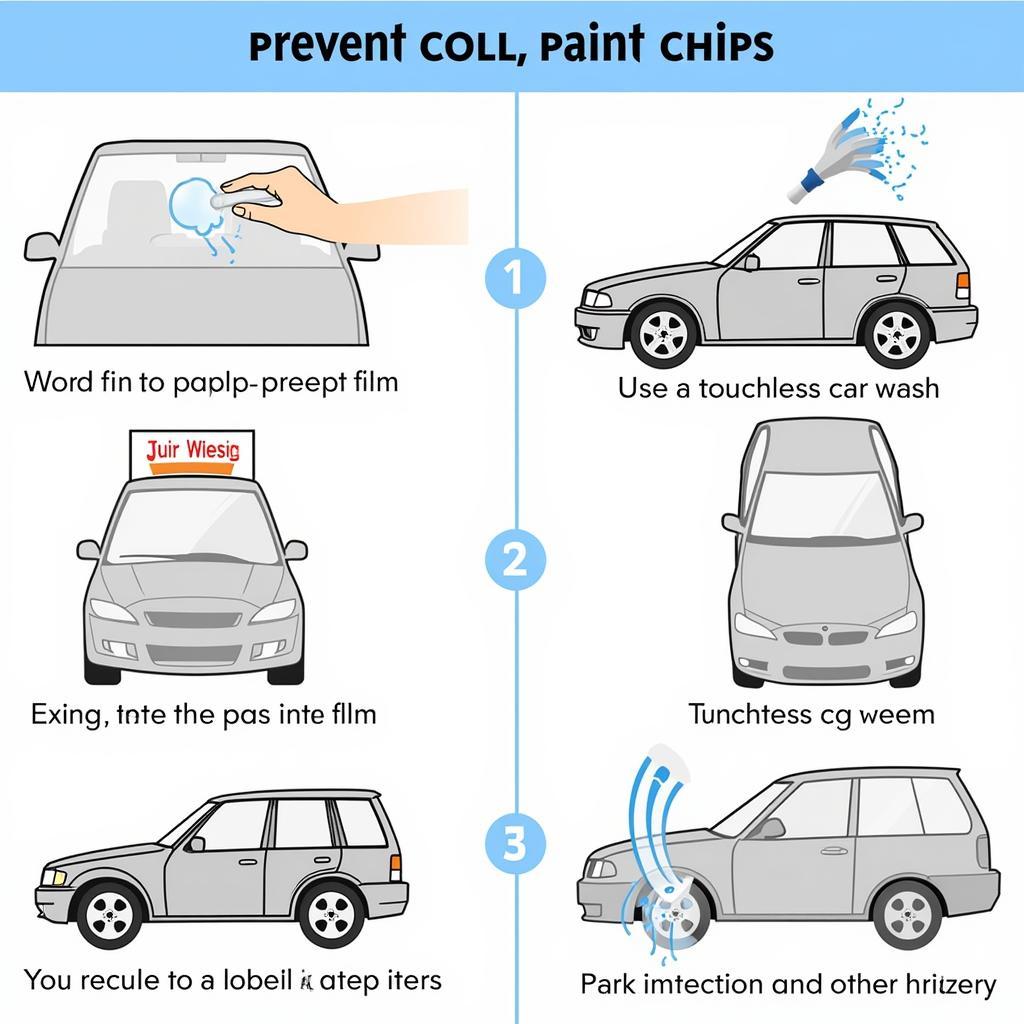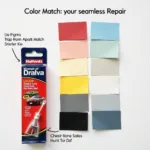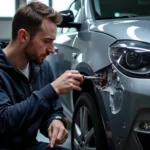Car exterior paint chip repair is a common concern for car owners. Whether from road debris, minor accidents, or even everyday wear and tear, these small blemishes can detract from your car’s appearance and potentially lead to more serious problems like rust. Understanding the best methods for car exterior paint chip repair is crucial for maintaining your vehicle’s value and aesthetics. This guide will equip you with the knowledge and resources you need to tackle those pesky paint chips effectively.
Addressing small paint chips early is often a simple DIY project, saving you the cost of professional repairs. However, larger or more complex chips might require the expertise of a qualified technician. Knowing how to assess the damage and choose the right repair method is the first step. This involves understanding the different types of paint chips, the tools required, and the various repair options available. Learn more at our car exterior paint chip repair service.
Assessing the Damage: Types of Car Paint Chips
Identifying the type of paint chip is essential for determining the appropriate repair method. A small chip that only affects the clear coat requires a different approach than one that penetrates the base coat or primer.
Clear Coat Chips
These are the most superficial type of chip, affecting only the outermost layer of your car’s paint. They appear as small, clear or slightly cloudy spots.
Base Coat Chips
These chips expose the underlying primer and are more noticeable than clear coat chips. They often appear as small, colored spots.
Primer Chips
These are the deepest type of chip, exposing the bare metal underneath. If left untreated, primer chips can quickly lead to rust.
DIY Car Exterior Paint Chip Repair Methods
For minor chips affecting the clear coat or base coat, DIY repair is often feasible. Here’s a step-by-step guide:
- Clean the Area: Thoroughly clean the chipped area with soap and water, then dry it completely.
- Sand the Area (If Necessary): If the chip is rough, lightly sand it with fine-grit sandpaper.
- Apply Touch-Up Paint: Carefully apply touch-up paint to the chip using a fine-tipped brush or a touch-up pen.
- Level the Paint: Use a paint leveling solution to smooth out the touch-up paint and blend it with the surrounding area.
- Apply Clear Coat (If Necessary): If the chip penetrated the base coat, apply a layer of clear coat after the touch-up paint has dried.
- Polish and Wax: Once the repair is complete, polish and wax the area to restore shine. Need help with chrome paint chips? See our guide on how to repair chipped chrome paint on exterior of car.
When to Seek Professional Car Exterior Paint Chip Repair
Larger chips, chips that have penetrated to the primer or metal, or chips that are accompanied by rust should be addressed by a professional. A professional repair ensures a flawless finish and prevents further damage.
Why Professional Repairs Matter
“Professional car exterior paint chip repair is more than just aesthetics,” says John Smith, Automotive Paint Specialist at Smith Auto Body. “It’s about preventing rust and maintaining the structural integrity of your vehicle.”
Preventing Car Exterior Paint Chips
While some paint chips are unavoidable, proactive measures can minimize their occurrence.
- Regular Washing and Waxing: Keeping your car clean and waxed creates a protective barrier against environmental damage.
- Parking Carefully: Avoid parking in areas prone to debris or door dings.
- Using Paint Protection Film: Consider applying paint protection film to vulnerable areas like the front bumper and hood.
What are some common causes of paint chips?
Rocks, gravel, and other road debris are common culprits. Minor accidents and even everyday wear and tear can also cause paint chips. Find a reputable car paint repair service in your area. We recommend car paint repair bradford or car paint repair sheffield.
 Preventing Car Paint Chips Techniques
Preventing Car Paint Chips Techniques
Car Exterior Paint Chip Repair: Conclusion
Car exterior paint chip repair is crucial for preserving your car’s appearance and preventing further damage. By understanding the types of chips, the repair options available, and the preventative measures you can take, you can keep your car looking its best for years to come. Remember, addressing paint chips promptly is key to avoiding more costly repairs down the line. If you’re unsure about tackling a repair yourself, always consult a professional for expert advice and assistance. For those in the Mackay area, we recommend car paint repair mackay.
FAQ
- How much does professional car exterior paint chip repair cost? The cost varies depending on the size and location of the chip, as well as the type of paint.
- Can I use nail polish for car exterior paint chip repair? Nail polish is not recommended as it is not formulated for automotive paint and may cause further damage.
- How long does touch-up paint take to dry? Drying times vary depending on the type of paint and the ambient temperature.
- Can I repair a paint chip myself if it has rusted? Rust requires special treatment and is best handled by a professional.
- How often should I wax my car to prevent paint chips? Waxing every three months is generally recommended.
- What is paint protection film? Paint protection film is a clear, durable film that is applied to the car’s paint to protect it from chips, scratches, and other damage.
- Is it necessary to apply clear coat after touch-up paint? Applying clear coat is recommended if the chip penetrated the base coat.
Common Car Exterior Paint Chip Repair Scenarios
- Scenario 1: Small rock chip on the hood. This can typically be repaired with a DIY touch-up kit.
- Scenario 2: Larger chip on the bumper exposing the primer. This likely requires professional repair to prevent rust.
- Scenario 3: Multiple chips along the side of the car from road debris. A professional can assess the damage and recommend the best repair option.
Further Reading and Resources
For more information on car maintenance and repair, explore our other helpful articles on CarRepairOnline.
Need help? Contact us via WhatsApp: +1(641)206-8880 or Email: [email protected]. We offer 24/7 customer support.


